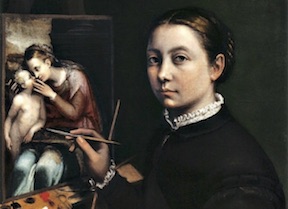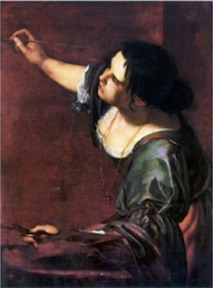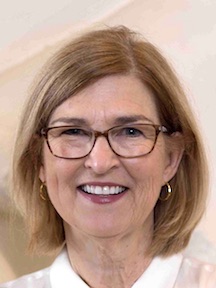By Jacob Morrow-Spitzer
Is biology destiny? According to Aristotle, says Nicola M. Courtright, the William McCall Vickery 1957 Professor of the History of Art at Amherst College and a 2018-2019 Phi Beta Kappa Visiting Scholar, the answer is yes. The widely influential ancient philosopher believed that a certain “biological system of gendering” applied to humans, which provided specific attributes that characterized each sex. Yet while this innately sexist belief existed throughout early modern Europe, Courtright holds that women broke their mold of inferiority more often than is generally believed. Presenting at Bowdoin College’s Kresge Auditorium on March 29, Courtright quite diligently argued that despite widely being considered biologically unequal to men, numerous representations of women exist in early modern European art that push back against these commonly held biological hierarchical notions.
To a captivated audience of students, academics, local Phi Beta Kappa members, and the general public in Brunswick, Maine, Courtright provided an engaging narrative rooted in historical art, a medium she described as often “able to tell us more than text [can]—and sometimes quite different things about the power of women.” As a scholar of many mediums, geographies, and eras of European art, Courtright holds extensive credentials. After finishing her undergraduate at Oberlin College and a master’s degree at Yale, she began a PhD at NYU’s Institute of Fine Arts, which she completed in 1990. She has published widely in 16th and 17th century European art history, including a book entitled The Papacy and the Art of Reform in Sixteenth-Century Rome: Gregory XIII and the Tower of the Winds in the Vatican (2003) and an upcoming volume tentatively titled A Paradoxical Queen: Marie de’ Medici and the Art of Authority. She lectures in all eras of Western European art, and teaches seminar courses focusing on Renaissance and Baroque art. In addition to her endowed chair at Amherst, she serves as the Vice Chair of the Board of the American Council of Learned Societies and the Vice President of the National Committee for the History of Art.
At Bowdoin, her public lecture entitled “Imagining Feminine Power in European Art” moved through periods and places in early modern Europe to show ways in which women achieved and demonstrated masculine-prescribed authority in society. Displaying art from both well-known and lesser-studied painters, as well as sculptures, diptychs, and other mediums of art, Courtright’s talk transitioned swiftly between categories of slides she entitled the “Christian Contribution,” “Portraits,” “Queens,” “17th Century Holland,” and “Women Artists and Their Self-Representation.” Through these examples, Courtright eloquently argued that, “selectively, women were represented positively, as rational, virtuous, and of course ideal, but even as ambition creators themselves who were on par with men.”
One of the more fascinating segments of her lecture was of women’s own evolving role in European art. Similar to other aspects the patriarchal society, female artists were generally restricted in what they could paint. Perhaps most importantly, women were prohibited from painting subjects in the nude. In places like France and Italy, where the most important paintings were of historical events (such as military battles), Courtright explained that “you had to be able to draw people from the nude and understand their anatomy. This was out of the question for women artists, yet they flourished.” Furthermore, she stated, female artists “cast doubt upon this idea that women were not smart or rational,” as in the example of Sofonisba Anguissola’s 1555 depiction of women playing chess—a military game of strategy.
Female artists’ societal positions are often evident in their own self-portraits, Courtright continued. Through the contrasting examples of a self-portrait by Anguissola in 1556 and Artemisia Gentileschi’s “Self-Portrait as the Allegory of Painting,” she demonstrates that a deeper dichotomy existed than the presently narrow view of early modern European women. In her portrait, Anguissola paints herself stiffly and “in very modest attire, in black clothing up to the neck,” Courtright explained. Yet in Gentileschi’s self-portrait, painted in 17th century Italy, she conveys a much different portrayal of female artists in Enlightenment-era Europe. Gentileschi is shown in a very active pose while painting, and in doing so, her painting depicts a “three-dimensional carnal woman who is able to break through the ordinary way of looking at things,” Courtright observed.

Self-portrait, Sofonisba Anguissola, 1556

“Self-Portrait as the Allegory of Painting,” Artemisia Gentileschi, 1639
Through the Visiting Scholars Program—which connects successful and innovative scholars in the liberal arts and sciences to undergraduate Phi Beta Kappa members across the nation—Courtright has been able to meet with dozens of students and faculty members at Kalamazoo, Wellesley, Trinity, Hope, and Oberlin colleges, as well with museum curators, special collections librarians, and members of the public. At each college, she has guest lectured in different classes, including medieval art history, gender in art, an art studio course, and even a class on photography. While each school sets up slightly different programming for her (and she offers a number of different public lectures that the school can choose from), Courtright has been able to convey the importance and power of art to individual students, an experience she says has been incredibly rewarding.
To her, the mission of Phi Beta Kappa resonates deeply with her career in the liberal arts and her academic position within a liberal arts institution. Concepts like “discussing big ideas, interacting closely with other disciplines and promoting overarching themes of learning” happen every day at liberal arts colleges, Courtright said, and having a lecture series like the Visiting Scholars Program both promotes that mission and, most importantly, is “a public good,” she added.
Jacob Morrow-Spitzer is a recent graduate of Tulane University, where he majored in History and Jewish Studies and minored in Mathematics. He was inducted into the Alpha of Louisiana chapter of Phi Beta Kappa in May of 2018. He will begin his Ph.D. in History in the fall.




